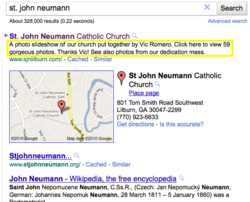Recently in Tech Category
In website design, you are restricted to a limited set of text fonts. You have to design based on the most common fonts people have installed. The complex data for drawing the font doesn't come across the web, but rather from the local operating system. You control this with style code that looks something like this:
body {font:15px arial, helvetica,sans-serif;}
Which means, try to use areial and if they don't have that, use helvetica, and if they don't have that use whatever san serif default font the reader has.
The only way to use a creative display font would be to be to make it a graphic and display it as an image, which would not be text and would not be sizable or searchable. It wouldn't really be a font.
As bandwidth has gotten greater... everyone is now watching YouTube and streaming Pandora... the concern about being so efficient with text has diminished. Why not send some extra font data with the page so everyone can read whatever font you want to use?
Google Web Fonts does just that. They have a nice little shopping tool that helps you browse different styles of fonts and then "check out" with the code to put at the top of your website. It is a specialized stylesheet call back to google fonts.
<head>
<link href='http://fonts.googleapis.com/css?family=Schoolbell' rel='stylesheet' type='text/css'>
After trying on some different fonts, I settled on a general text font for Mac5's home page called Cabin and then a fun display font for JEB:LOG titles called Schoolbell.

What's he building in there?
 I bought Parallels for our iMac some time ago so that Kathy and the kids could run things associated with school and work that had to be in a Windows environment. Mainly older school-based systems that required Explorer. We also needed to run Publisher sometimes.
I bought Parallels for our iMac some time ago so that Kathy and the kids could run things associated with school and work that had to be in a Windows environment. Mainly older school-based systems that required Explorer. We also needed to run Publisher sometimes.
I needed to run Parallels to diagnose a three month old clicking Seagate GoFlex 2TB USB drive. The diagnostics software only runs on Windows and is a required step before returning the drive for replacement. This continues a trend with external USB drives of about a 1 in 3 failure. It is really disappointing, and I've experienced it with Seagate, Western Digital, and LaCie.
Anyhow, fired up Parallels and found Claire had changed the Windows desktop. A much better version than the standard Windows desktop if I may say so myself! She did this in November of 2008 based on the graphic's file date. Pretty good trick, creating and replacing the Windows desktop for a kid raised on Macs.
Something to smile about when you have a broken hard drive. Feel free to download!
 Bob writes on his blog about how much he uses Google's various services. I read through his list and commented that he left off another three I know he uses. I use so many Google account based services that I have a bookmark folder titled "G" that holds them all. I recently changed my bookmark "Picassa" to "Photo" because that's how I think of it... where I put my Google photos.
Bob writes on his blog about how much he uses Google's various services. I read through his list and commented that he left off another three I know he uses. I use so many Google account based services that I have a bookmark folder titled "G" that holds them all. I recently changed my bookmark "Picassa" to "Photo" because that's how I think of it... where I put my Google photos.
Google check arrived. Third time I've reached $100 with Google Ads. I used Claire's iPod Touch to photograph and deposit the check into our USAA account, so that is different. I had a problem getting the USAA App to work. Kept getting a message it couldn't read the amount. So I covered up the asterisks before the number with a little piece of paper (see photo) and that worked. I've had problems with those asterisks before when doing a scan deposit.
June 2004: Started ads
Sep 2006: First check $100.05
Feb 2009: Second check $106.54
May 2011: Third check $100.83
7 Years. $307. Woo hoo!
This is just a test.
| 1-9-01 | iTunes available for Macs |
| 10-23-01 | 1G iPod 5 GB $399 |
| 1-18-02 | Ted gets 20GB Archos $279 |
| 3-20-02 | 10 GB $499 |
| 7-17-02 | 2G iPod: 5GB $299, 10 GB $399, 20 GB, $499. PC versions available. |
| 4-28-03 | 3G iPod: 10 GB $299, 15 GB $399, 30 GB $499. PC or Mac compatible. iTunes music store debuts, but for Mac only. |
| 9-8-03 | 20 GB $399, 40 GB $499 |
| 10-16-03 | iTunes for PC's |
| 11-12-03 | Ted gets 3G 20GB |
| 12-25-03 | Ted lends Archos to Danny indefinitely |
 I am surprised how high our church website ranks on a google search when there are many other SJN churches and even a wikipedia entry for St. John Neumann. I even logged out of Google so it would not bias the results. I'll give credit to the activity we have on the site with updates and cross-links to and from Facebook, YouTube, and Twitter.
I am surprised how high our church website ranks on a google search when there are many other SJN churches and even a wikipedia entry for St. John Neumann. I even logged out of Google so it would not bias the results. I'll give credit to the activity we have on the site with updates and cross-links to and from Facebook, YouTube, and Twitter.
I noticed the description for our site (the description meta tag on the home page) was not the default for the site, but instead one of the articles that appeared on the home page. (See yellow box in attached image.)
After a little digging, I found out that there was a bug in a plug-in I used to generate article meta description tags dynamically called autoMetaDescSEO. I started using this plug-in when we started using Facebook because a Facebook link will attempt to grab the page's description, which at the time was just the default for the website.
So the plug-in helped grab some relevant text from the SJN website page links. What I did not realize is that a bug caused one of the articles on the front page to place a meta description tag there, above the site meta description.
Fortunately Dao by Design has repaired this problem with a newer and renamed version of the plug-in now called SimpleSEO (a much simpler name.) The new plug-in has an option to not have the front page meta description auto generated. Google's robots should have our search result updated within 48 hours...
Mom published her first PDF version of the FOTA newsletter. I thought she might want to use Issuu to post it on the FOTA website. This is just a test....
 I noticed that Google now puts a little blue triangle / arrow next to the first entry of a search list. I wondered what good that was. Was it indicating the "best" find? I thought that is what the first position meant.
I noticed that Google now puts a little blue triangle / arrow next to the first entry of a search list. I wondered what good that was. Was it indicating the "best" find? I thought that is what the first position meant.
 So I googled on "blue triangle arrow google" and found out. You can use your up and down arrow on your keyboard to move the triangle to another choice. Then you can press the enter key to go to that choice. So it is a way to choose a result without having to point and click.
So I googled on "blue triangle arrow google" and found out. You can use your up and down arrow on your keyboard to move the triangle to another choice. Then you can press the enter key to go to that choice. So it is a way to choose a result without having to point and click.
In the snapshot attached, you can see where I've moved the arrow down one choice with my down arrow.
Now that I use a trackpad both on my laptop and at my desk, I don't mind pointing and clicking so much, because I just gesture and tap.

(But I like the flashlight Ted gave me!)
For years, whenever I have created a new account with a website or bought software that had a serial number, I would use notepad.yahoo.com to create a new note titled with the name of the software, company, or website and write hints to myself about account logins and passwords or any other information I might need. This is especially useful for infrequently visited sites or infrequently used information. (Ted uses his Palm Pilot iPod Touch this way.)
I routinely go to notepad.yahoo.com a few times a week and type a quick search to find the notes I need.
However, since I have not used Yahoo mail for a long time, I've always wanted to move all 156 notes over to either Google Docs or Google Contacts. Until today, I never was able to find an easy way to do it.
Today, a google search for "yahoo notepad export" listed at the top exactly what the doctor ordered. Greg Sadetsky created a page that will log into your Yahoo account, export the notes, and optionally create one Google Doc per note. Any labels for the notes are carried over to Google's label/folder tag.
I had to think carefully about doing this. I was giving someone I don't know access to both my Yahoo and Google accounts. And while I changed my logins to have temporary passwords, there is sensitive data behind those accounts. In some ways my Notepad notes were keys to everything else (although I only tend to store hints.)
Can I trust Greg?
I looked at his home page, his linked-in page, and how he wrote the FAQs for his utility. I concluded this was an honest guy who has written some clever code and has gone to the trouble to share it. He even offered a "safer" way to run the program myself by downloading the code.
I decided, sure, I can trust Greg. I ran the utility, and it worked! I had to actually run it 4 or 5 times to get all 156 notes to go over (deleting the incomplete, exported set each time.) The utility seemed to time out at random counts between 80 and 130 until it finally got to all 156. Not sure if it helped, but the last time, I kept bouncing between the utility, Google Docs, and Yahoo Notes to make sure none of the systems were timing out.
Not sure how many other Yahoo Notepad users are out there looking to migrate, but I can highly recommend Greg's work. Thanks Greg!

